This is a chronology of all major events from 527 AD.
527–565 Reign of Emperor Justinian I.
527–530 First incursions by Slavic tribes from the lower Danube into Thrace.
548 Slavic tribes from Pannonia cross the Danube and ravage the central parts of the Balkan Peninsula.
From mid-6th century, forays of Slavs into the Balkan Peninsula become more frequent.
582 Avars seize Sirmium.
582–602 Reign of Emperor Maurice. Last attempts at defending the northern border of the Empire from Avar and Slav assaults.
626 Avars and Slavs lay siege to Constantinople.
634 Serbs and Croats arrive at the invitation of Emperor Heraclius (610–641) to fight as allies of Byzantium against the Avars; in return, they are allowed to settle in Illyricum.
680 Bulgarians under Khan Asparuh settle east of the Danube.
c. 780–800 Reign of Serbian Prince Višeslav.
c. 800–820 Reign of Serbian Prince Prosigoj. Serbian land covers parts of todays Croatia, Bosnia, Montengro, Kosovo and Metohija, Albania, big part of Greece and part of Bulgaria.
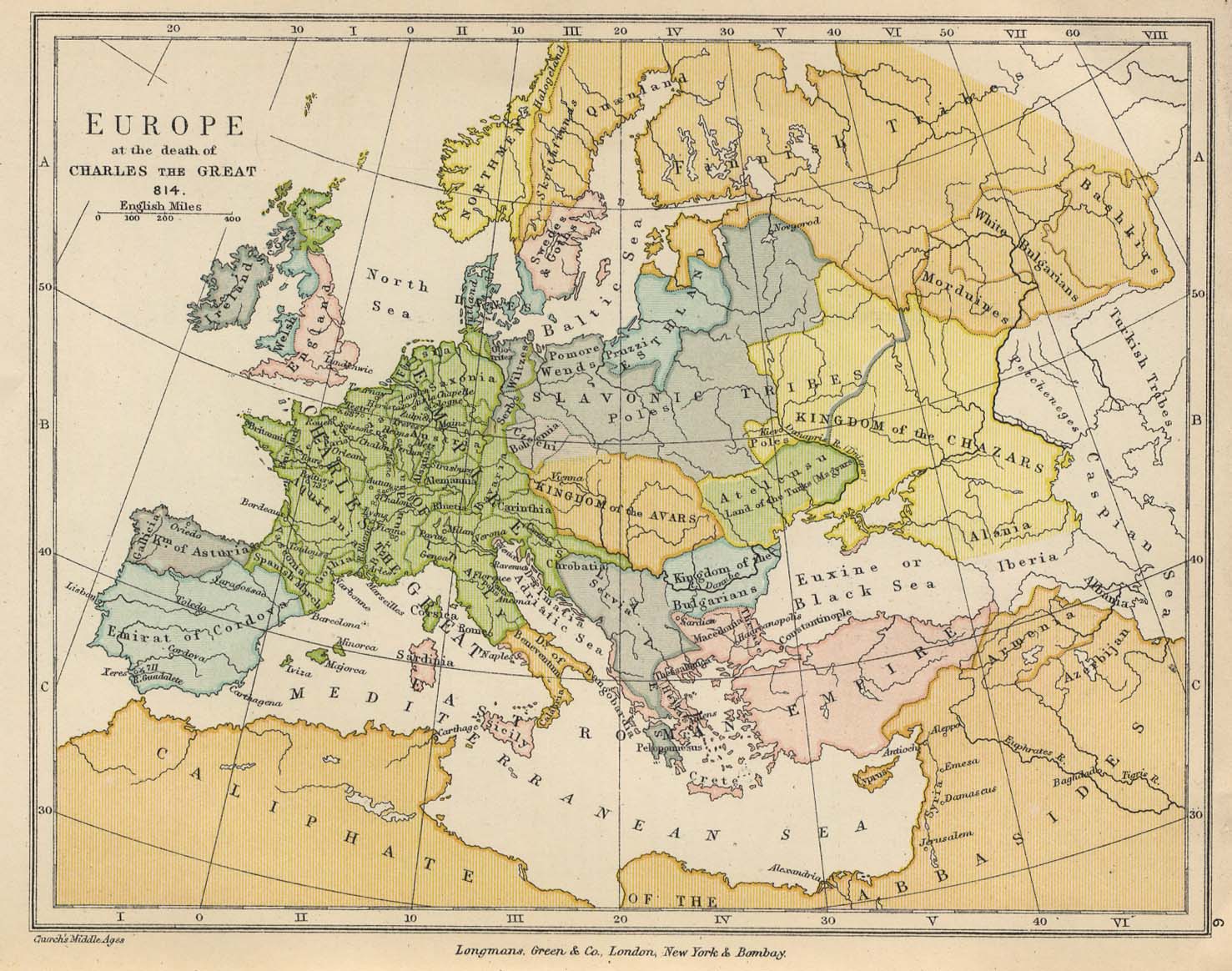
c. 850 Battles with Bulgarians successfully led by Prince Vlastimir and in later years also by his sons Mutimir, Strojimir and Gojnik.
c. 820–851 Reign of Serbian Prince Vlastimir.
851–891 Reign of Serbian Prince Mutimir.
867–886 Reign of Emperor Basil I.
854 Bulgarian Khan Boris attacks Serbia. After conclusion of peace, prisoners of war exchanged at Ras, when the place is first mentioned as a settlement, fort or region.
Between 867 and 874 Conversion to Christianity of the Serbian ruling family by the ecclesiastical centers on the Adriatic coast. Serbian princes recognize the supreme power of the Emperor.
892–917 Reign of Serbian Prince Petar Gojniković.
913–959 Reign of Emperor Constantine VII Porphyrogennetos.
c. 926 Temporary occupation of Serbia, until 927, by the Bulgarian army led by Tsar Simeon.
c. 933–c. 950 Reign of Prince Časlav.
c. 950 Dubrovnik diocese elevated to archdiocese, with jurisdiction over the regions of Serbia, Travunia and Zachlumia.
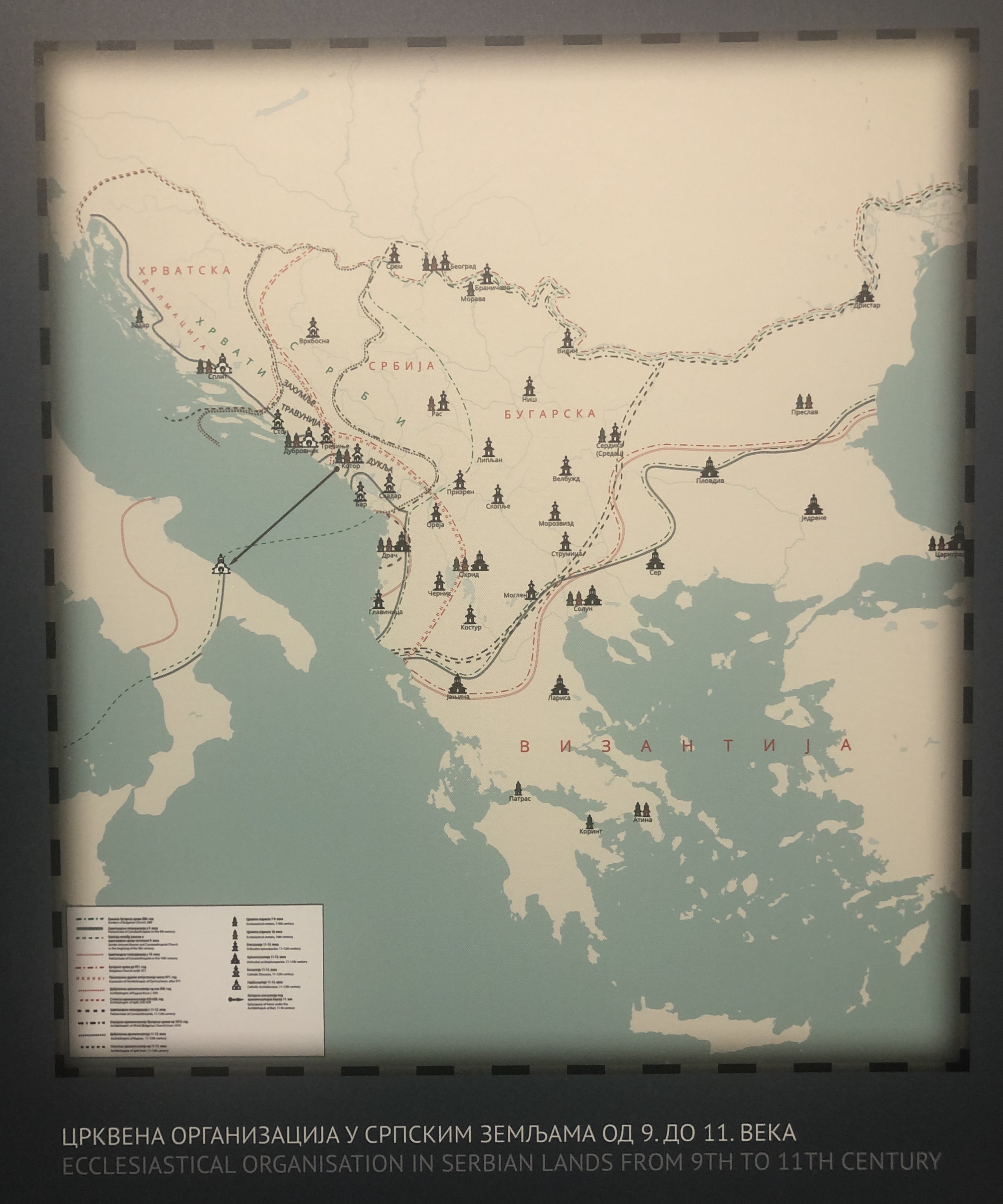
1000-1016 Knez Jovan Vladimir Serbian ruler of the state of Duklja. 1018 Following the collapse of the Bulgarian Empire, Byzantine Emperor Basil II establishes the Katepanate of Bulgaria and Theme of Serbia.
1019–1020 Byzantine Emperor Basil II designates the territorial size of the Archbishopric of Ohrid, also comprising the Bishopric of Ras.
1039–1042 Prince Vojislav seizes control of Serbia and Dioclea and subsequently of Travunia and Zachlumia.
1064 Hungarians seize Byzantine Belgrade.
1072 Aborted uprising against Byzantine rule in the theme of Bulgaria. The rebels proclaim Bodin, son of Prince Mihailo of Dioclea, Tsar of Bulgaria.
1077 King Mihailo of Dioclea seeks the papal flag from Pope Gregory VII.
c. 1085 King Bodin of Dioclea seizes the region of Ras and appoints Vukan and Marko to govern it.
1089 Diocese of Bar elevated to archdiocese.
1094 Meeting of Emperor Alexios Komnenos and Ras Župan Vukan.
1096 The Crusader army passes through the territory of present-day Serbia, taking the military route from Belgrade, through Niš and Sofia, to Constantinople, while one part of the army makes its way along the roads towards the Adriatic coast.
1118–1143 Reign of Emperor John II Komnenos.
c. 1122 Emperor John Komnenos seizes Ras.
1127 During the Byzantine-Hungarian war, Serbs seize the fortress of Ras. Grand Župan Uroš I marries his daughter Jelena to the Hungarian heir to the throne, the future king Bela the Blind.
1129 Byzantine army seizes Ras and Grand Župan Uroš I recognizes the supreme authority of the Emperor, pledging to provide him with troops.
1143–1180 Reign of Emperor Manuel I Komnenos.
1147 Two large Crusader armies, led by German Emperor Konrad III and French King Louis VII, pass through Serbia, along the military road from Belgrade through Niš and Sofia to Constantinople.
1166–1196 Reign of Grand Župan Stefan Nemanja.
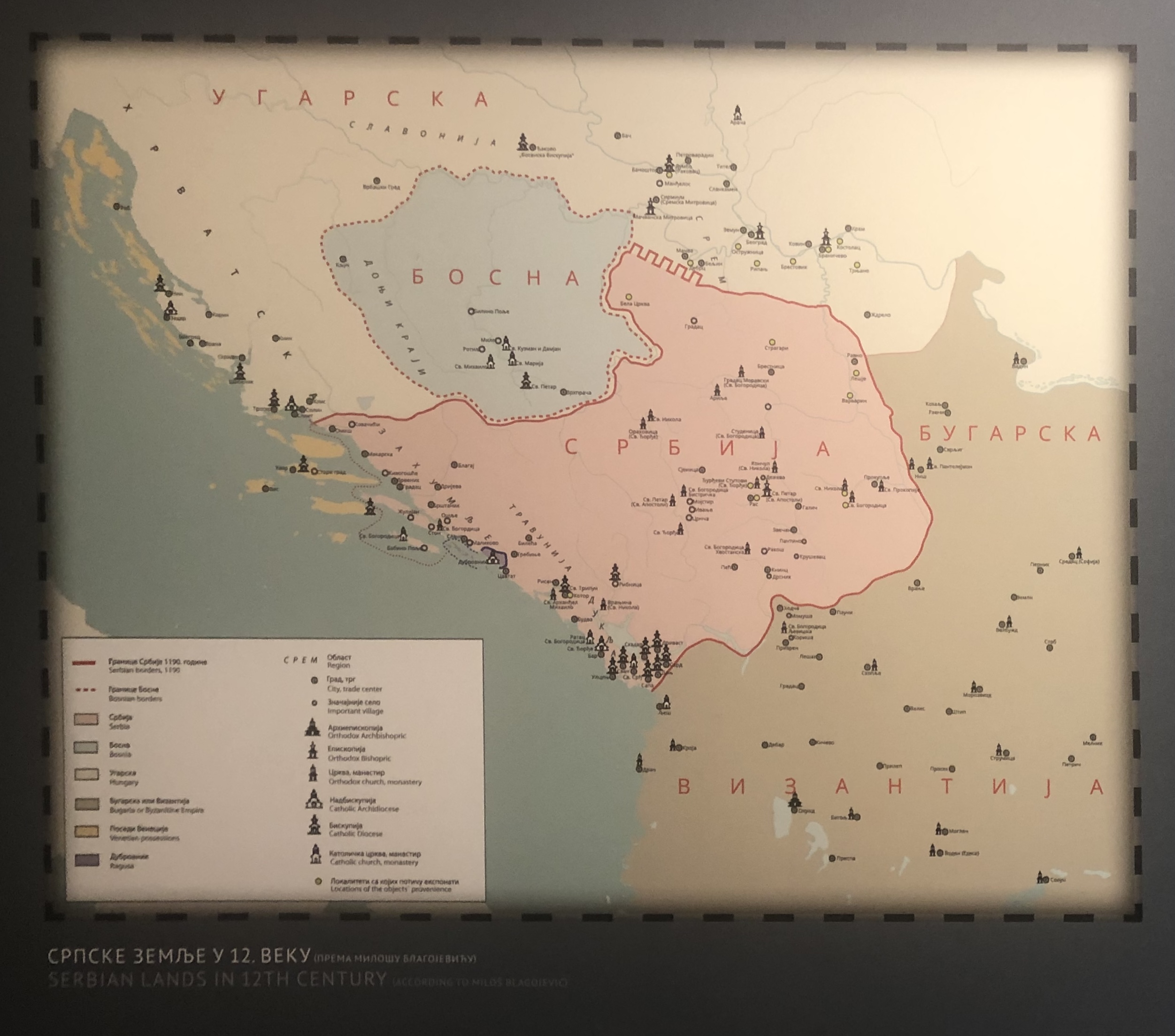
1172 Stefan Nemanja’s attempt to renege on his allegiance to Byzantine authority fails. Manuel I Komnenos captures the grand župan, who marches in the emperor’s triumphal procession on the streets of Constantinople.
1180–1183 Reign of Emperor Alexios II Komnenos. Following his assassination, Stefan Nemanja refuses to recognise the authority of the new emperor, Andronikos I Komnenos and begins to seize control of Byzantine territories.
1185–1195 Reign of Emperor Alexios III Angelos.
1189 During the Third Crusade, Stefan Nemanja and Friedrich Barbarossa meet at Niš and discuss forming an alliance.
1191 In a battle on the South Morava, the Serbian army is defeated by Byzantium. Nemanja returns a small number of conquered territories to the Byzantine emperor and his middle son and heir, Stefan, marries the emperor's niece Eudokia.
c. 1192 Rastko Nemanjić goes to Mount Athos, takes monastic vows and changes his name to Sava (1174–1236).
1195–1203 Reign of Emperor Alexios III Angelos.
1196 Stefan Nemanja abdicates in favour of his son Stefan, now a nephew-in-law of the Byzantine emperor and withdraws to the Monastery of Studenica as the monk Simeon, and subsequently to Mount Athos, the following year.
1198 The monks Simeon and Sava reconstruct the Hilandar monastery on Mount Athos.
1196–1227 Reign of Stefan Nemanjić.
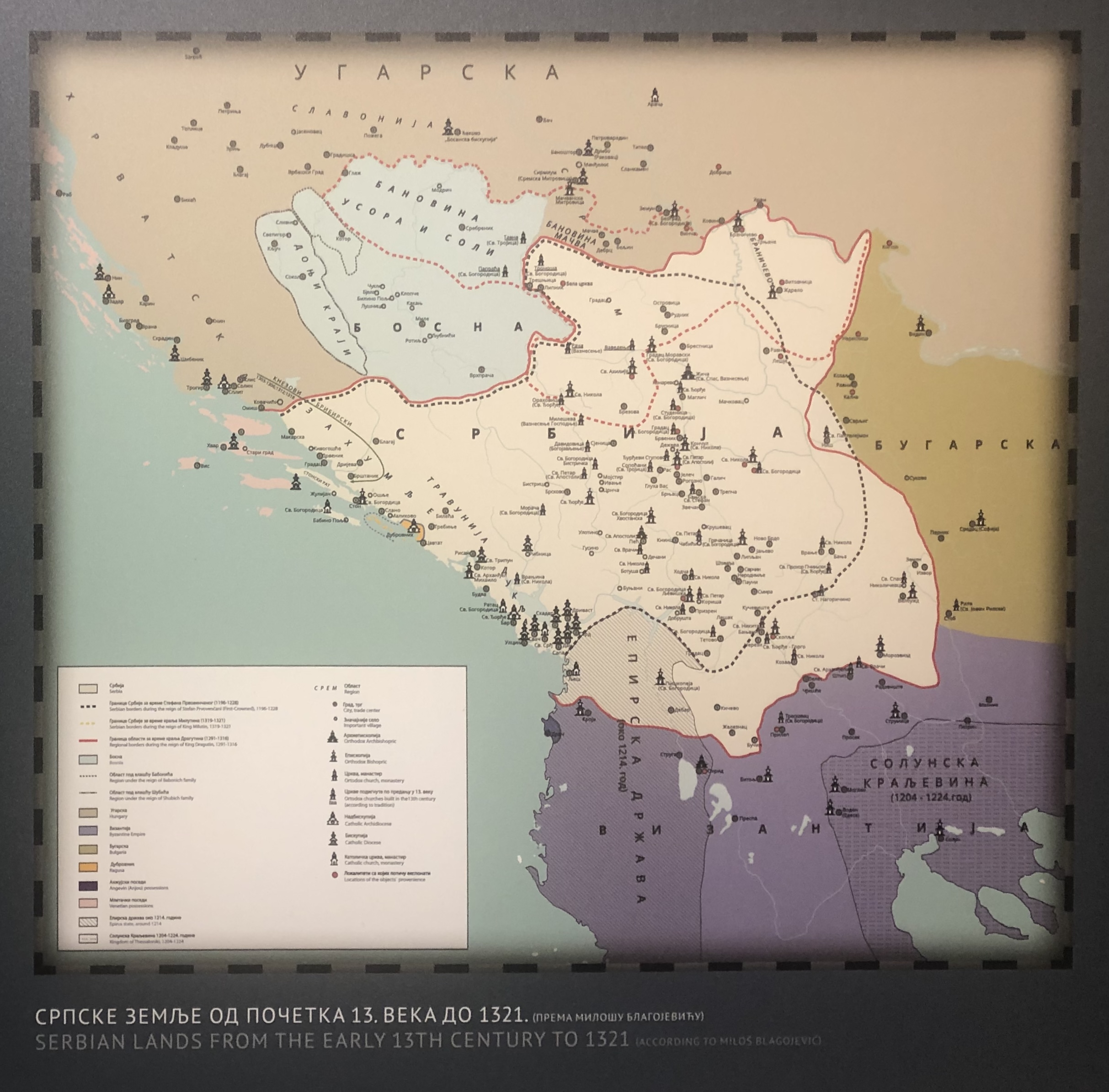
1204 Fourth Crusade. The Crusaders seize Constantinople and divide the Byzantine Empire.
1204–1261 Empire of Nicaea. The house of Nemanjić considers it to be the successor to the old Empire.
1204–1221 Reign of Nicaean Emperor Theodore I Laskaris.
1217 Coronation of Stefan Nemanjić as the first crowned king ‘of all the Serbian and maritime lands’– by legates sent to him by Pope Honorius III.
1219 Consecration of Archimandrite Sava Nemanjić as the first archbishop ‘of all Serbian and maritime lands’ in Nicaea; the Ecumenical Patriarch and the Council in Nicaea give the Serbian Archbishopric the right to autocephaly. The Monastery of Žiča becomes the seat of the archbishop and the coronation church.
1228-1233 Reign of King Stefan Radoslav.
1221–1254 Reign of Nicaean Emperor John III Vatatzes.
1236 Archbishop Sava dies in the Bulgarian town of Trnovo; the following year his relics remains are transferred to the Monastery of Mileševa.
1243–1276 Reign of King Stefan Uroš I.
1259–1282 Reign of Michael VIII Palaiologos.
1261 Restoration of the Byzantine Empire at Constantinople.
1274 King Stefan Uroš I rejects the Union of Lyon.
1276–1282 Reign of King Stefan Dragutin.
1282–1328 Reign of Andronikos II Palaiologos.
1282 At the Council of Deževo, King Dragutin abdicates in favour of his brother Milutin and receives his own, separate lands.
1282–1321 Reign of King Stefan Uroš II Milutin.
1284 Hungarians grant Dragutin governance of northern Serbia and north-eastern Bosnia. Belgrade comes under Serbian rule for the first time.
c. 1291 Kuman-Tatar invasion of Serbia; Žiča is burned down. The seat of the Serbian Archbishopric is moved to Peć.
1298–1299 Byzantine-Serbian negotiations. Peace is concluded in 1299 and strengthened by the marriage between King Milutin and Simonida, the daughter of the emperor, Andronikos II Palaiologos. Milutin’s conquests till then, the most important among them, northern Macedonia with Skopje, are recognized in the form of a dowry.
1314 King Milutin captures, nearly blinds and exiles his son Stefan III Dečanski because of the latter’s revolt against his authority. Stefan with his sons spends nearly seven years in Constantinople. 1321-1324 Reign of King Stefan Vladislav II.
1321–1331 Reign of Stefan Uroš III Dečanski.
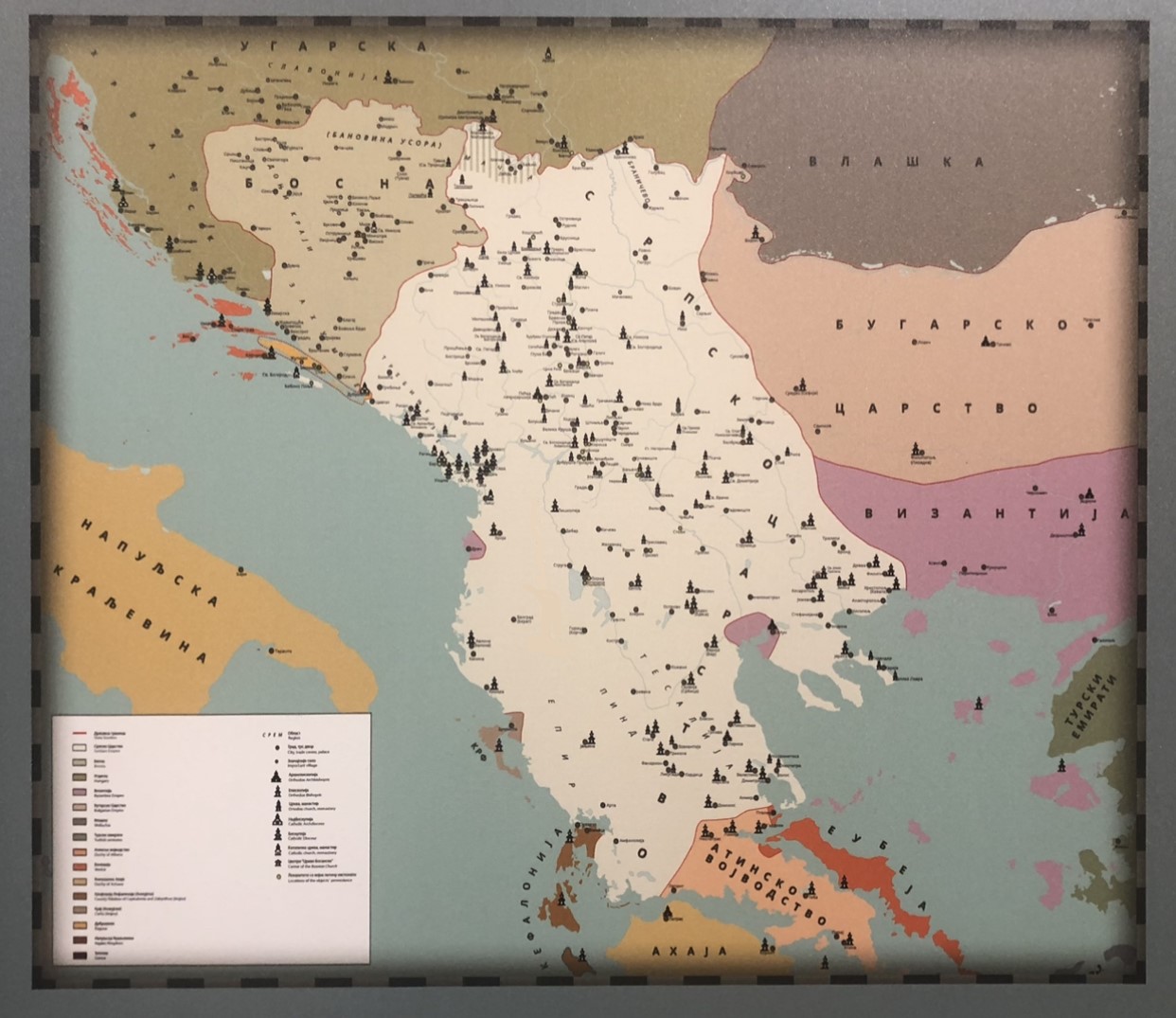
1322-1353 Reign of Ban Stefan II Kotromanic.
1324–1337 Administration of Serbian Archbishop Danilo II.
1328–1341 Reign of Andronikos III Palaiologos.
1330 Battle of Velbuzhd – victory of the Serbian army led by Stefan III Dečanski over Bulgarian Tsar Michael. Stefan Dušan, the young king, demonstrates great courage in battle.
1331–1355 Reign of King Stefan Dušan. Under King and later Emperor Dusan Serbia again covers most of the lands from 814 map which includes part of todays Bosnia, Montengro, Kosovo and Metohija, Albania, big part of Greece and part of Bulgaria.
1334 King Dušan conquers regions in central Macedonia, including Ohrid and Prilep.
1341–1354 Civil war in Byzantium, between the regents of the under-aged John V Palaiologos, and John Kantakouzenos, who proclaims himself emperor and protector of the Palaiologoi.
1341–1391 Reign of John V Palaiologos.
1342 Alliance between John Kantakouzenos and King Dušan. The king’s conquests in south-western Macedonia and northern Epiros.
1343 Alliance of regents with King Stefan Dušan, who, from that time, in his traditional title of ruler ‘of all the Serbian and maritime lands’ adds ‘of the Greek lands’.
1345 King Dušan seizes control of Serres, south-eastern Macedonia and Mount Athos
End of 1345 /beginning of 1346 King Dušan proclaims himself as the emperor of Serbia and part of the Byzantine Empire; he most often uses the title ‘vasilevs and autokrator of Serbia and Romania’ (in Greek) and ‘emperor of the Serbs and Greeks’ (in the Serbian language).
1346 Imperial coronation of Stefan Dušan in Skopje. The Serbian Church is elevated to the status of a patriarchate and Archbishop Joanikije is consecrated as the first Serbian patriarch.
1347–1354 Reign of John V Kantakouzenos.
1347 Emperor Dušan takes control of Epiros.
1348 Emperor Dušan takes control of Thessaly.
1349 Dušan’s Code proclaimed at a state assembly in Skopje. (The Code is later amended and proclaimed at an assembly in Serres in 1354).
1352 Constantinopolitan Patriarch Kallistos and the Synod pronounce an anathema against Emperor Dušan and Patriarch Joanikije and the Serbian bishops (the so-called Kallistos’ Anathema) because of Dušan’s coronation as Byzantine Emperor and the raising of
the Serbian Church to the status of a patriarchate.
1352 The Battle at Demotika, in which John Kantakouzenos and the Turks defeat the supporters of Emperor John V Palaiologos, the Serbs and the Bulgarians.
1354 Turks seize the city of Gallipoli, and establish their first stronghold in Europe.
1355 Emperor Dušan dies of unknown causes. The dissolution of his state soon leads to an epoch of internecine conflict among the numerous regional overlords.
1355–1371 Reign of Emperor Stefan Uroš V.
1365 Vukašin Mrnjavčević receives the title of king and becomes the co-ruler of Emperor Uroš V until 1371.
1371 Battle of the Maritsa; King Vukašin and Despot Uglješa Mrnjavčević are killed. Vukašin’s son Marko, then the ‘young king’ gains the title of king. With the death of Emperor Uroš V, the male line of the Nemanjić family is extinguished. 1371-1395 Rule of District of Branković by Nobleman Vuk Branković.
1372–1389 Reign of Prince Lazar Hrebeljanović.
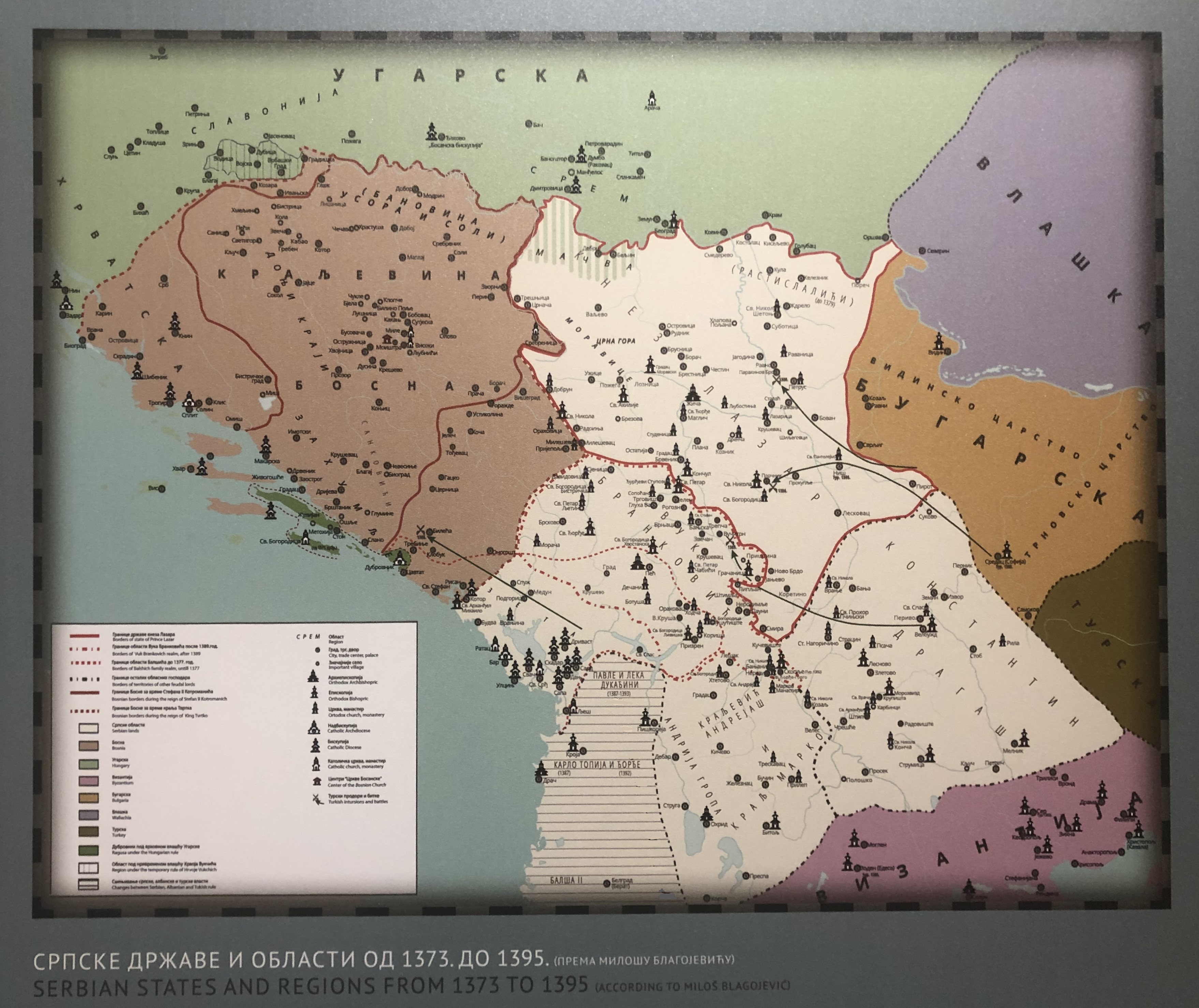
1375 Reconciliation of the Serbian and the Byzantine churches. The Ecumenical Patriarchate gave absolution Dušan, Uroš, Joanikije and the bishops; the Peć archbishop’s title of patriarch is recognized in internal communication, and Dušan’s title of the Emperor of Serbia is posthumously recognized.
1376–1379 Reign of Andronikos IV Palaiologos.
1377 The Bosnian ban Tvrtko I Kotromanić is crowned as the king of the Serbs, Bosnia, the Pomorje (maritime) and western lands. 1385-1403 Rule of Zeta by Nobleman Djuradj II Balsic Stracimirovic
1389 The Battle of Kosovo; death of Prince Lazar and Sultan Murad.
1391–1425 Reign of Manuel II Palaiologos.
1395 The Battle at Rovine; King Marko and Despot Konstantin Dejanović, the vassal of the Ottoman Sultan Beyazid, are killed.
1402 The Battle of Angora, in which Stefan Lazarević fights as the vassal of Sultan Beyazid. On his return from the battlefield, in Constantinople the Byzantine emperor awards him the highest title, that of ‘despot’.
1402–1427 Reign of Despot Stefan Lazarević. 1402-1412 Rule of Kosovo by Djuradj and Lazar Brankovic.
1403–1404 Belgrade becomes the capital of the Serbian state (till 1427). 1404-1408 Reign of King Stefan Tvrtko II Kotromanic.
1408 Despot Stefan Lazarević is awarded the title of Knight of the Order of the Dragon, established by Hungarian King Szigismund. 1421-1443 Another reign of King Stefan Tvrtko II Kotromanic.
1425–1448 Reign of John VIII Palaiologos. 1427-1456 Reign of Despot Djuradj Brankovic.
1428–1430 The building of Smederevo, the new capital of the Serbian state.
1439 Despot Djuradj rejects the Florentine Union. Smederevo falls for the first time.
1440 First Ottoman siege of Belgrade (ruled by Hungary).
1449–1453 Reign of Constantine XI Dragases Palaiologos.
1453 May 29th Turks seize Constantinople. Sultan Mehmed II makes a ceremonial entry into the city, which becomes the capital of the Ottoman Empire – Istanbul.
1455 Turks seize Novo Brdo.
1456 Second Ottoman siege of Belgrade (ruled by Hungary). 1456-1458 Reign of Despot Lazar Djurdjevic Brankovic.
1459 Smederevo falls to the Turks, and the end of the Serbian medieval state. 1459-1463 Reign of King Stefan Tomasevic Kotromanic.
1463 Turks seize control of Bosnia.
1471 Hungarian King Matthias Corvinus awards Vuk Branković the title of despot. The restored despotate in Srem becomes a kind of military frontier between the Christian and Ottoman worlds.
1486 Djordje Branković appointed despot in Srem.
1490 Djuradj Crnojević becomes the Lord of Zeta.
1502 With the death of Despot Jovan, the male line of the house of Branković is extinguished.
Early 16th century Having taken monastic vows, Djordje Branković, now the monk Maksim, becomes the Metropolitan of Belgrade.
1520–1566 Reign of Turkish Sultan Suleiman the Magnificent.
1521 A major Turkish offensive. Belgrade seized along with other cities and part of the Serbian population is carried away to Istanbul.
1526 The Battle of Mohacs. Following the defeat of Hungary and the death of King Vladislaus, the Turks establish a stronghold in Central Europe.
1529 Sultan Suleiman the Magnificent’s first campaign against Vienna. In order to put up a front against the Turks, Serbs are settled along the Austrian - Turkish border.
1541 Hungary falls to the Turks.
1557 The Patriarchate of Peć restored.
1592 The fall of the city of Bihać to the Turks marks the end of Turkish conquests in Bosnia, Herzegovina, Croatia, Slavonia, and Dalmatia.
1594 As a result of an uprising against the Turks in the Banat, Sinan-pasha has the relics of Saint Sava transferred from the Mileševa monastery and burned in Belgrade.
1595–1610 Intensive settling of Serbs in modernSlavonia and Croatia. The Military Frontier created.
1614–1647 Administration of the Serbian Patriarch Pajsije.
1630 Austrian Emperor Ferdinand II passes the Statutes, which provide for the special status of the Serbs living in the territory of the Military Frontier.
1683 Aborted Turkish siege of Vienna.
1683–1699 The Great (Viennese) War waged against the Turks by the Holy League – an alliance of Austria, the Roman Curia, Poland and Venice – is of crucial importance for the history of the Serbs.
1689 After the withdrawal of the Austrian army from Skopje and its defeat at Kačanik, the Turks launch a counteroffensive, followed by retaliation and devastation. The majority of the Serbian population, led by Patriarch Arsenije III Čarnojević, withdraw to the territories north of the Sava and Danube rivers, which become part of the Austrian Empire after the Treaty of Karlowitz in 1699. First Great Migration came as a result of the Habsburg retreat and Ottoman reoccupation of southern Serbian regions, which were temporarily held by the Habsburgs between 1688 and 1690. 1699 Members of the Holy League – the Habsburg Monarchy, the Polish-Lithuanian Commonwealth, the Republic of Venice and the Russian Empire – conclude a peace treaty with the Ottoman Empire in which the territories of modern Vojvodina and Slavonia are passed to the Habsburg Empire in the Treaty of Karlovci. Following the Congress Sremski Karlovci and Novi Sad become major hubs of Serbian culture in the Habsburg Empire. Serbs enter the Enlightenment period alongside other Western nations leaving behind the previous Ottoman-imposed values. 1748 Holy Roman Empress Maria Theresa gives royal city rights to Novi Sad, the biggest Serbian settlement in this Empire, following the capitulation of Habsburg Serbia. The city becomes known as Serbian Athens and a place of Serbian national revival. Most of Serbian culture, including its patriarchy (Metropolitanate of Karlovci), is now "in exile" across the Danube and Sava rivers overlooking Ottoman Serbia to the south. More Serbian cities are granted a Free Royal Status in years to come chiefly by Maria Theresa of Austria: Sombor, Bečkerek, Subotica (Maria-Theresiopolis), etc. 1755 Serbs permanently settle in the Russian Empire fleeing from Ottoman onslaughts in the Balkans. The Czar gives them the territories of Nova Serbia and Slavo-Serbia. Today these Serbs are mostly assimilated into Ukraine although their traces still reflect in toponyms such as the city of Slovianoserbsk and the district of Slovianoserbsk in south-eastern Ukraine. 1766 Turks abolish the Serbian Orthodox Church, subjugating it to Constantinople. Two Serbian Patriarchs have found refuge in the Habsburg Empire during the preceding migrations. Southern Serbia slowly becomes Muslim in character, following the colonization of Muslim Albanians and Turkish peoples. 1778 The first Serbian Faculty is established in Sombor, Habsburg Empire, under the name Teacher's College. It is the oldest higher-education facility in the region. 1804 The First Serbian Uprising was an uprising of Serbs in the Sanjak of Smederevo against the Ottoman Empire from 14 February 1804 to 7 October 1813. Initially a local revolt against renegade janissaries who had seized power through a coup, it evolved into a war for independence (the Serbian Revolution) after more than three centuries of Ottoman rule and short-lasting Austrian occupations. Napoleon annexes the Bay of Kotor to the First French Empire as a part of the Illyrian provinces. The Venetian Republic collapses after almost 1000 years of existence. 1808 The country's Narodni Zbor (Revolutionary Parliament) adopts the first constitutional act in this part of Europe defining Serbia as a constitutional monarchy under Karađorđe's supreme rule.
1813 The Revolutionary Serbia is crushed facing the Ottomans as they invade the country with 200,000 soldiers. The lack of support from Imperial Russia, who were at war against Napoleon at the time, also contributed to the Serbian defeat. Widespread revenge attacks upon civilians, nobles and "Intelligentsia" trigger a second insurrection. 1815 The Second Serbian Uprising was the second phase of the Serbian Revolution against the Ottoman Empire, which erupted shortly after the re-annexation of the country to the Ottoman Empire in 1813. The occupation was enforced following the defeat of the First Serbian Uprising (1804–1813), during which Serbia existed as a de facto independent state for over a decade. The second revolution ultimately resulted in Serbian semi-independence from the Ottoman Empire. The Principality of Serbia was established, governed by its own parliament, constitution and royal dynasty. De jure independence, however, was attained in 1878, following the decisions of the Congress of Berlin. 1816 The Ottoman governor, Marashli Ali Pasha, approves partial autonomy for the rebel province pressured by Imperial Russia and the Habsburg Empire– the supervisors and protectors of the Serbian people in the Sultanate. 1848 The Spring of Nations erupts in Europe. The Serbs of Habsburg Empire demand self-rule according to the 1691 charter of Leopold I, Emperor of Austria. The Serbs proclaimed the creation of autonomous Serbian Vojvodina in Sremski Karlovci as the Serb army in the Habsburg Monarchy clashes with the Hungarians. 1850 In Vienna Serbian and Croatian linguists agree to create a unified literary language based on the Shtokavian dialect. It becomes known as Serbo-Croatian for the next 150 years. The aim is to establish closer cultural ties between the two closest nations and boost local Serbian support for the Croatian cause.
1860 Franz Joseph of Austria abolishes the Serbian crown land of Voivodship of Serbia and Tamiš Banat igniting a revolt among Serbs without any success. 1867 The Habsburg Empire is replaced by the Dual monarchy of Austria-Hungary. The Serbian lands are split between the two.Southwards, in the Principality of Serbia, Serbs rebel against the Ottoman authorities following the bombardment of Belgrade. Great Britain and France urge the Ottomans to withdraw their troops from Serbia. The Principality of Serbia is now de facto independent— 50 years after the Second Serbian Uprising. 1869 Subotica, one of the biggest Serbian settlements, is connected to the West by railway. 1873 Banat Krajina is abolished and included into Transleithania; despite the wishes of the majority Serbs and Germans. This is the first step towards the destruction of the Serb-populated Military Frontier inherited from the Habsburg Empire. By 1883 the Military Frontier is entirely abolished and incorporated into the Kingdom of Hungary and the Kingdom of Croatia-Slavonia, save for the Bay of Kotor (Austria). 1877 The Russo-Turkish War begins. The majority peoples, the Bosnian Serbs, launch an uprising against the Ottomans in Nevesinje declaring their unification with the Principality of Serbia. Nikola Pašić and Nicholas I of Montenegro proclaim the formal independence of Serbia and Montenegro. The Ottoman Empire declares war on Serbia and Montenegro. 1878 Christian troops besiege Istanbul. Western interference stops the collapse of Ottoman Turkey by acknowledging de jure independence of Montenegro, Serbia and Romania with the Treaty of Berlin: all of whom have already been sovereign for some time prior to the Congress. 1882 The Kingdom of Serbia (5th Serbian Realm) is proclaimed under austrophile King Milan Obrenović following a corruption scandal he was involved in. 1885 The Serbo-Bulgarian War results in the country's humiliation following the Unification of Bulgaria increasing hostility toward the House of Obrenović. 1889 King Milan Obrenović abdicates the throne in favour of his minor son Aleksandar Obrenović. Austrophile policy continues. 1893 Aleksandar Obrenović assumes power following a coup d'état.
1903 The May Coup d'etat results in the assassination of the royal couple King Aleksandar Obrenović and Queen Draga Mašin by Black Hand activists. 1906 The Pig War between Austria-Hungary and the Kingdom of Serbia begins. Austria imposes an economic blockade on Serbia following Serbia's decision to improve cooperation with France, Britain and Bulgaria. Serbia eventually triumphs with the aid of Western allies. 1908 At the peak of the economic blockade Austria-Hungary annexes Bosnia and Herzegovina triggering the Bosnian crisis in Europe.The Young Turk Revolution starts within the Ottoman Empire. As Bulgaria proclaims independence Serbia starts looking toward Kosovo and Macedonia in the south having to accept the Bosnian occupation. 1910 The Kingdom of Montenegro is proclaimed in Cetinje under King Nicholas I of Montenegro. His long-term program is the restoration of the Serbian Empire with himself as an Emperor. Two rival Serbian dynasties now fight for supremacy among Serbs. 1912 The Balkan Wars begin as Montenegro and Serbia declare war on the Ottoman Empire followed by Bulgaria and Greece. The Balkan League besieges Constantinople. Albania proclaims independence from the Ottoman Empire and is approved in the Treaty of London forcing Serbo-Montenegrin troops to withdraw from the country.
1914 28th June The Assassination in Sarajevo of Archduke Franz Ferdinand sparks a major European crisis. The July Ultimatum is delivered to Serbian authorities demanding that Austro-Hungarian troops march into Serbia. The Kingdom of Serbia rejects the proposal supported by Imperial Russia, France and Great Britain. Austria-Hungary and the German Empire declares war on the Kingdom of Serbia triggering the outbreak of World War I. 1914 August The Battle of Cer marks the First Allied Victory in the War as the Serbian First Army under field marshal Stepa Stepanović pushes the Austro-Hungarian Army across the Drina and Sava rivers expelling them from the Kingdom of Serbia. Serbia suffers 16,000 casualties, compared to 30,000 Austro-Hungarian casualties in this part of the Serbian Campaign. Later Austria-Hungary launches the 2nd invasion on the Kingdom of Serbia. Belgrade population falls from 110,000 to 20,000 following the bombing from the Sava and Danube rivers. The Battle of Kolubara begins resulting in the second decisive victory of the Serbian First Army and retreat of Austria-Hungary across the rivers a month later. Field marshals Radomir Putnik and Živojin Mišić's strategy has been hailed throughout the country. Serbia is free for almost a year but at a terrible cost; it lost approximately 170,000 men – almost a half of its entire army. 1915 October A typhus epidemic begins, 150,000 people die in Serbia this year alone. The country's population has already dropped by 10% since the beginning of the war. The 3rd invasion of Serbia begins. Austria-Hungary conquers Belgrade marching toward the south. Bulgaria invades Serbia cutting its supply route from Greece. The Serbian First Army is forced to retreat across the Sar Mountains of Albania and Kosovo. Despite Austro-Hungarian and Bulgarian occupation and the retreat of Serbian Army the Kingdom of Serbia never capitulated. The Yugoslav Committee, founded by the Austro-Hungarian Serbs and Croats in exile, is proclaimed in London. Its primary goal is the liberation of the South Slavic lands from Austro-Hungary with the intention of joining the Kingdom of Serbia. The secret London Pact (pictured) offers, among many other European territories, western Dalmatia to the Kingdom of Italy and the eastern parts to the Kingdom of Serbia that would also be combined with Bosnia and Herzegovina, most of Slavonia and a large part of Vojvodina and northern Albania. 1918 October Austria-Hungary capitulates disintegrating into several states, the largest one being the State of Slovenes, Croats and Serbs governed from Zagreb. Joint Serbian, British and French forces expel Bulgaria from the pre-war Serbian territories (including Kosovo and Macedonia). Bulgaria capitulates. World War I comes to an end following the decisive Entente Powers victory. Contribution to the Entente had large consequences: the Kingdom of Serbia has lost 28% of its entire prewar population falling from 4.5 to 3.2 million people. Syrmia breaks off from the State of Slovenes, Croats and Serbs and joins the Kingdom of Serbia. Vojvodina (Banat, Bačka and Baranja) joins the Kingdom of Serbia by the decision of the Serb National Board in Novi Sad. The Kingdom of Montenegro overthrows its dynasty of the Petrović and accepts the supremacy of the House of Karađorđević. 1918 November The State of Slovenes, Croats and Serbs joins the Kingdom of Serbia fearing the possible Italian invasion. The newly created South Slavic state is considered a legal successor of the Kingdom of Serbia and is openly labelled as hostile by the Kingdom of Italy which was hoping to annex the rest of Istra, Dalmatia and Montenegro. The Kingdom of Serbs, Croats and Slovenes (First Yugoslavia) is proclaimed in Belgrade under Regent Alexander I. Belgrade unites with Zemun and Pančevo (formerly Serb-populated cities under the Habsburg Monarchy).
1919 January The Christmas Uprising erupts in Montenegro as supporters of the House of Petrović, allegedly aided by the Kingdom of Italy, oppose to acknowledge the Karađorđević dynasty and the decision of the Grand National Assembly. Guerilla clashes would continue for another 6 years and result in the defeat of the separatists. 1919 September Italian fascist Gabriele d'Annunzio enters the Free State of Rijeka bringing the two neighbours to the verge of war. 1920 The Treaty of Rapallo recognizes the state's independence. 1921 The Kingdom of Italy invades Rijeka and annexes it despite Belgrade's objections. 1924 The Balkan Entente is formed by the Kingdom of Serbs, Croats and Slovenes, the Kingdom of Romania, Greece and Turkey as a counterbalance to the revisionists (chiefly Italy and Hungary). It also served as a buffer-zone with the Soviet Union. 1929 January 6 Dictatorship is introduced by King Alexander of Yugoslavia following the assassination of the Croatian Peasant Party leader and the most important Croatian politician at the time, Stjepan Radić, by a Montenegrin Serb member of the Serbian People's Radical Party, Puniša Račić. The Constitution is suspended and the Parliament dissolved as the King starts his 2-year dictatorship aimed at restoring order in the ethnically divided Kingdom. The state is renamed as the Kingdom of Yugoslavia and its internal borders are reintroduced through 9 banovinas. 1931 The new Constitution of the Kingdom of Yugoslavia is introduced by King Alexander putting an end to his 2-year long dictatorship. The Croatian question again becomes activate again as many start demanding federalization of the unitary monarchy. Many Croatian politicians end up in prison, including Vlatko Maček leader of the CPP, under the pretext that they dismiss the Constitution. 1934 9th October King Alexander I of Yugoslavia is assassinated in Paris France by the Bulgarian and Croatian fascists, Vlado Černosemski and the Ustaše. Prince Paul temporarily seizes the throne. Alexander's son Peter II was a minor at the time. 1939 Former political prisoner Vlatko Maček is appointed vice premier of the Kingdom of Yugoslavia following an appeasement policy of the Royal Court towards the Croats. An autonomous Banovina of Croatia is carved out of large parts of Croatia as well as parts of Bosnia and Vojvodina. As Vlatko Maček announces the potential independence of the province and a deep crisis in the Kingdom follows. Yugoslavia has started to disintegrate. 1941 25th March Prince Paul of Yugoslavia signs the Tripartite Pact in Vienna fearing an invasion of the Axis Powers into his weakened Kingdom. After the Coup d etatt, conducted under command of generals Simović and Mirković supported by British intelligence with 300.000 pound sterling, massive demonstrations erupt in downtown Belgrade as an overwhelming majority of Serbs denounce the Pact Treaty. Following a military coup d'état 17-year-old Peter II assumes the throne naming Dušan Simović as his chief general. The Kingdom of Yugoslavia withdraws its support for the Axis Powers on March 27th. 1941 6th April Massive German Luftwaffe airstrikes hit the Yugoslav capital as Hitler decides to crush the rebellion causing 17,000 casualties in the Battle of Belgrade. Other Serbian cities follow suit such as Leskovac, Kraljevo and Niš. The Kingdom of Italy, Third Reich, Fascist Hungary and Fascist Bulgaria invade and dismantle the Kingdom of Yugoslavia aided by Banovina of Croatia, Albania and some domestic minorities.The Kingdom of Yugoslavia capitulates as its royal army disintegrates following the evacuation of the royal family to Africa and a multi-party occupation. Greece succumbs to the Axis 10 days later. Operation Barbarossa begins with a months delay enabling the Soviet Union to regroup during the Axis invasion of Southern Europe. The Yugoslav Army, a guerilla force loyal to the Kingdom of Yugoslavia's government in exile, is founded on Ravna Gora by Colonel Draža Mihajlović. Until the Yalta conference in 1943 this royal army would be considered a chief ally to Great Britain, the U.S.A. and the Soviet Union. Their chief opponents within the country would be the communist Yugoslav partisans.The Serbian division of the Partisan resistance movement, loyal to communists of Josip Broz Tito, launches an uprising in the Nazi-occupied town of Užice proclaiming it a free state, The Republic of Užice. Uprisings also erupt in Italian-held Montenegro, Bosnia and Slovenia. Užice succumbs to the Germans 4 months later. First clashes between the Royalists of Draža Mihajlović and the Communists of Josip Broz Tito occur at this time over the supremacy in the Yugoslav resistance movement; these two rival movements fight both each other and the Axis powers and this expand the civil war on territory of Bosnia and Hercegovina: Communist partisans, Royalist četniks and forces of NDH (Nazi Independent State of Croatia). 1941 September Captain D. T. Hudson of the Royal Navy, meets with the commander of the royalists, Draža Mihajlović. 1941 October After the attacks by guerrilla groups of royalist četniks and communist partizans on German occupying forces and liberating of significant territory in western Serbia. German occupation forces retaliate by shooting more the 10.000 hostages in several Serbian cities. As Fascist Italy capitulates in October, Nazi troops march into its territories along the coast of Yugoslavia (Dalmatia, Herzegovina, Montenegro, Raška, Kosovo). The 2nd Congress of AVNOJ (Anti-Fascist Council of National Liberation of Yugoslavia) proclaims the Yugoslav federation, denouncing the King's right to return to the country after World War II is over. The next day, the Tehran Conference, a meeting between Joseph Stalin, Franklin D. Roosevelt and Winston Churchill, decides to shift their support from the Yugoslav Royal Army to their rivals, the Communist Yugoslav partisans, and de facto legitimize a Communist regime in Yugoslavia. 1944 June The Royal Yugoslav government in exile recognizes the partisans as Yugoslavia's legitimate armed forces, ordering the Royal Army to join the newly named Partisan Yugoslav army, following the Tito-Šubašić agreement on the Adriatic island of Vis. The King calls for Serbs, Croats and Slovenes to unite into a single army under partisan flag. Draža Mihajlović and many of his četniks refuse to obey and continue fighting on their own, with neither royal nor Allied support, calling on Serbs to emancipate themselves from Yugoslavia in the form of Greater Serbia. 1945 January The YNLA liberates the Jasenovac concentration camp, following a retreat of Nazi and Ustaše forces. 50,000 prisoners who were able to walk were freed and led from the camp. Massive destruction of data preceded the liberation, making it hard to determine the extent of the Serbian Genocide. The numbers reach several hundred thousand victims. Aided by the Soviet army, Yugoslav Partisans expel fascist and Nazi forces from the country, ultimately defeating the royalists as well. Ustaše flee the country. Yugoslav Danube Germans are also forced to leave the country, as well as many Hungarians and Italians. 1945 November Federal People's Yugoslavia or Second Yugoslavia is proclaimed by the Yugoslav Federal Parliament in Belgrade. The monarchy is officially abolished and the royal family banned from entering the country.
Copyright © 2020